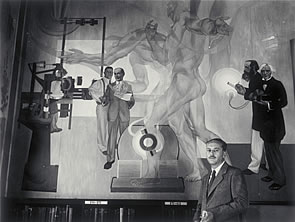 |
Stanton Macdonald-Wright at the unveiling of the library murals in 1935 [Santa Monice Public Library Image Archives] |
Stanton Macdonald-Wright (1890-1973) created one of the most extensive mural cycles in Southern California at the Santa Monica Public Library in the mid-1930’s. Covering over 2,000 square feet of wall, and including 160 figures, it amazed visitors when it was unveiled on August 25, 1935. The mural series was on view for three decades before it was dismantled when the library moved. Because it had been created as part of the New Deal art projects, the mural was transferred to the federal government. Most of the series remained in storage for many years near Washington, D.C. In 2005 the mural was returned on loan from the Smithsonian American Art Museum to be conserved and reinstalled in the new Main Library when it opened in January 2006.
Macdonald-Wright was California’s first internationally acclaimed modern artist. Raised in Santa Monica, he moved to Europe in 1909 to continue his art studies and was influenced by some of Europe’s most avant-garde art circles. He soon met another American painter Morgan Russell (1886-1953), and together they founded the color abstraction movement, Synchromism, exhibiting in Munich, Paris and New York. In the fall of 1918, Macdonald-Wright returned to Los Angeles where he disrupted the staid, Impressionist-dominated art world with his progressive modernist theories and painting.
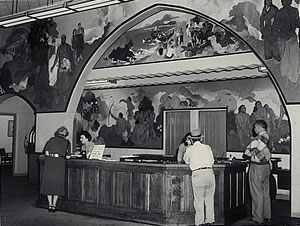 |
| Circulation Desk with Stanton MacDonald-Wright Mural ca. 1935. Santa Monica Public Library Image Archives |
By 1934 America was in the grips of the Great Depression, and like other unemployed workers, artists sought relief from President Franklin D. Roosevelt’s New Deal programs that were designed to put people back to work. It was Macdonald-Wright’s own idea to paint a mural for the library. His proposal was enthusiastically received by city of Santa Monica officials, and money was quickly raised for materials. The mural was initially sponsored by the short-lived Public Works of Art Project (PWAP) and was begun in February 1934. It was completed 18 months later under the auspices of the State Emergency Relief Administration (SERA). Macdonald-Wright painted the mural entirely by himself, working without compensation so that technicians could be hired to help with preparation and installation.
Macdonald-Wright explained to Mayor William H. Carter and other city administrators that his intention was “to create a work that will have a meaning for people from every country of the globe.” It is significant that the artist abandoned abstraction in favor of creating a narrative that was understandable to the ordinary man-on-the-street with some mural scenes resembling book illustrations or movie clips. What Macdonald-Wright did retain, however, was his brilliantly-hued palette: golden yellows, flaming oranges, deep reds, delicate pinks, and lively greens give the mural his distinctive mark.
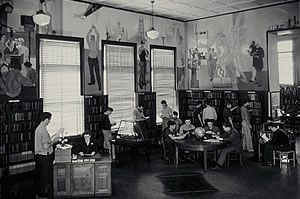 |
Stanton Macdonald-Wright Mural on the Walls of the Reference Area, 1935. Santa Monica Public Library Image Archives |
The mural cycle covered every available wall of the reading room of the Main Library, then located at 503 Santa Monica Boulevard. It was painted on more than 30 plywood panels that were originally positioned above bookcases, across archways, and around doors and windows, resulting in the unique shapes of many of the panels. When visitors entered the library their attention was directed to the opposite (north) wall above and behind the circulation desk where the mural began. There scenes from prehistory with primitives battling enormous monster spirits set the historical tone. The rest of the mural followed two narrative streams of human development: the creative arts’ panels wrapped around the room along the northeast, east and southeast walls; and scientific achievements were depicted on the opposite side of the room along the northwest, west and southwest walls.
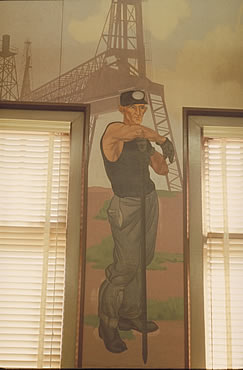 |
| Coal Miner Panel in Old Main Library, 1964. Santa Monica Public Library Image Archives |
Large mural cycles about the history of mankind had become a well-established tradition for public buildings in the United States. Macdonald-Wright began the arts narrative with Asian philosophers and famous ancient myths, moving through 18th- and 19th-century German music to contemporary musicians and ending with the American poet and short-story writer Edgar Allan Poe (1809-1849). He traced scientific and technical achievements from ancient Greece through the Renaissance to the modern utilization of electricity and other energy sources, culminating with the figure of Lee H. De Forest (1873-1961), a pioneer in sound, radio, and the motion picture industry. Macdonald-Wright explained:
"The … two streams of human development: one technical, the other imaginative … coalesce and fuse in what perhaps holds the greatest potentialities for art expression invented by man—the medium of the moving picture. Those who have been in a moving picture stage and laboratory during tshe filming of a picture know what a great role the inventions along the lines of precision machinery, chemistry, and electricity, play in the process."
Macdonald-Wright was one of the first of many muralists working in the 1930’s to slant his historical presentation to local achievements. He set noted Santa Monicans, actors Gloria Stuart (b. 1910) and Leo Carrillo (1880-1961), before a backdrop that is a glorious panorama of Santa Monica Bay. Motion pictures not only represented a hometown industry to Macdonald-Wright but also related to his life-long experiments with film and color. Other autobiographical elements appear in other panels. The lariat thrower is his friend, artist Thomas Hart Benton; the dog in the prologue is his own; and the painter at an easel is his father, to whom the mural is dedicated.
Contrary to the typically European-centered attitudes of most American muralists of the time, Macdonald-Wright’s interests were wide-ranging. He was as well versed in Asian philosophy as he was in Western modern painting, appreciating various cultures with equal passion. Indeed, it was in the 1930’s that he began seriously exploring the arts and religious beliefs of Asia through reading and travel. In his painted history of humanity’s accomplishments, he balanced emblems from the West with those of the East. His choice of personalities (both actual and mythical) demonstrated his multicultural perspective: from Aristotle and Socrates to Confucius, Buddha and LaoTzu.
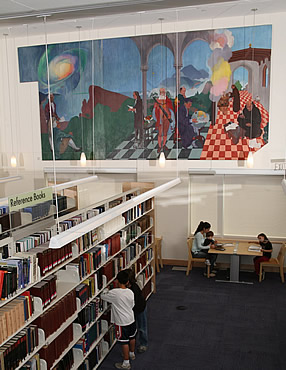 |
Laplace, Herschel, Newton, Galileo, Copernicus and Bacon Panels in New Main Library, 2006. William Short Photography |
Traditionally a mural is a fresco painted in wet plaster that becomes a permanent part of the wall. Muralists in the United States broke with that practice by painting on canvas instead. Macdonald-Wright, however, had plywood panels specially prepared. This technique, termed “portable murals,” was also utilized by famed Mexican muralist Diego Rivera (1886-1957) in the early 1930’s. Such a procedure enabled easy removal from the wall if necessary. This is exactly what happened in 1965 when the library moved to a newly-constructed building located at 1343 Sixth Street. Deemed too old-fashioned, the Depression-era mural cycle was not transferred to the new facility, and the federal government took possession of all the mural panels.
Macdonald-Wright went on to become active in public art. From 1935 to 1942 he worked tirelessly as both an artist and a local administrator for the largest of the government art projects, the Works Progress Administration’s Federal Art Project (WPA/FAP). But it was the Santa Monica Public Library Mural that began this aspect of his career. Fortunately, with the mural’s conservation and reinstallation on the second floor of the new Main Library, it is now possible for new generations to enjoy this historically significant work.
The City of Santa Monica wishes to thank the Smithsonian American Art Museum for the loan of the mural. Conservation and installation of the mural was by ConservArt Associates and funded by the City of Santa Monica and the California Cultural and Historical Endowment.
Text: Ilene Susan Fort, Mural Consultant
![]()
Santa Monica Public Library Mural Flyer
[PDF: 2pg., 71KB]


